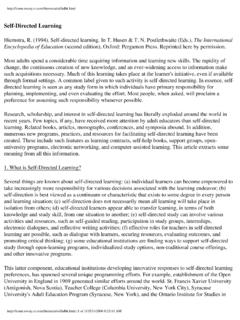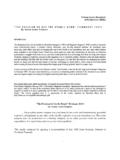Transcription of iess B3 H-O - Columbia University
1 Tors and despots ( , Adolf Hitler, Joseph Stalin), havebeen described as narcissistic. In addition narcissism hasbeen examined as a potential factor in political criminology narcissistic personality traits are thoughtto predict criminal behavior, including murder, rape,assault, spousal abuse, and white-collar crime. Narcissismis also a key feature of a psychopathic personality, which isperhaps the most important personality profile for pre-dicting serious criminal significant issues remain unresolved in the sci-entific study of narcissism. First, there remains debate overthe definition of narcissism. While there is strong agree-ment on key features of narcissism like grandiosity andlow empathy, there is disagreement about the linkbetween narcissism and feelings of depression or unhappi-ness.
2 Some theorists argue that narcissism contains a com-ponent of depression or low self-esteem; others argue thatnarcissism is related to positive emotions. Still othersargue that narcissism is linked to negative emotions andself-perceptions but that these feelings are experiencedonly at an unconscious level. Second, while there are sev-eral theories about the development of narcissism in indi-viduals, there is no firm conclusion about its researchers argue that narcissism results from per-missive parenting, while others argue that narcissism is areaction to cold, controlling parents. Finally, the role ofculture in maintaining narcissism is not well researchers and theorists have identified a rising tideof narcissism, but the cause of this remains ALSOF reud, Sigmund; Individualism; Leadership;Neuroticism; Obsession; Personality; Political Science;PsychologyBIBLIOGRAPHYA merican Psychiatric Association.
3 1994. Diagnostic andStatistical Manual of Mental Disorders. 4th rev. , DC: , Sigmund. [1914] 1957. On Narcissism: An The Standard Edition of the Complete Psychological Works ofSigmund Freud, ed. and trans. James Strachey, vol. 14,67 104. London: , Christopher. 1978. The Culture of Narcissism: AmericanLife in an Age of Diminishing Expectations. New , Carolyn C., and Frederick Rhodewalt. 2001. Unravelingthe Paradoxes of Narcissism: A Dynamic Self-regulatoryProcessing Model. Psychological Inquiry 12 (4): 177 Keith CampbellJoshua D. MillerNASH EQUILIBRIUMNash equilibrium is a fundamental concept in the theoryof games and the most widely used method of predictingthe outcome of a strategic interaction in the social sci-ences.
4 A game (in strategic or normal form) consists of thefollowing three elements: a set of players, a set of actions(or pure-strategies) available to each player, and a payoff(or utility) function for each player. The payoff functionsrepresent each player s preferences over action profiles,where an action profile is simply a list of actions, one foreach player. A pure-strategy Nash equilibriumis an actionprofile with the property that no single player can obtaina higher payoff by deviating unilaterally from this concept can best be understood by looking atsome examples. Consider first a game involving two play-ers, each of whom has two available actions, which we callAand B.
5 If the players choose different actions, they eachget a payoff of 0. If they both choose A, they each get 2,and if they both choose B, they each get 1. This coordi-nation game may be represented as follows, where player1 chooses a row, player 2 chooses a column, and the result-ing payoffs are listed in parentheses, with the first compo-nent corresponding to player 1 s payoff:The action profile (B,B)is an equilibrium, since aunilateral deviation to Aby any one player would result ina lower payoff for the deviating player. Similarly, theaction profile (A,A) is also an another example, consider the game matchingpennies, which again involves two players, each with twoactions.
6 Each player can choose either heads (H) or tailsNash EquilibriumFigure 1(1,1) (0,0)BA(0,0)(2,2)A B Figure 2(1, 1) ( 1,1)TH( 1,1)(1, 1)H T 540 INTERNATIONAL ENCYCLOPEDIA OF THE SOCIAL SCIENCES, 2ND EDITION iess_B3_H-O 4/12/07 4:13 PM Page 540(T); player 1 wins a dollar from player 2 if their choicesare the same, and loses a dollar to player 2 if they are game has no pure-strategy Nash some cases, instead of simply choosing an action,players may be able to choose probability distributionsover the set of actions available to them. Such randomiza-tions over the set of actions are referred to as mixed strate-gies. Any profile of mixed strategies induces a probabilitydistribution over action profiles in the game.
7 Under cer-tain assumptions, a player s preferences over all such lot-teries can be represented by a function (called a vonNeumann-Morgenstern utility function) that assigns a realnumber to each action profile. One lottery is preferred toanother if and only if it results in a higher expected valueof this utility function, or expected utility. A mixed strat-egy Nash-equilibrium is then a mixed strategy profile withthe property that no single player can obtain a highervalue of expected utility by deviating unilaterally from American mathematician John Nash (1950)showed that every game in which the set of actions avail-able to each player is finite has at least one mixed-strategyequilibrium.
8 In the matching pennies game, there is amixed-strategy equilibrium in which each player choosesheads with probability 1/2. Similarly, in the coordinationgame of the above example, there is a third equilibrium inwhich each player chooses action Awith probability 1/3and Bwith probability 2/3. Such multiplicity of equilib-ria arises in many economically important games, and hasprompted a large literature on equilibrium refinementswith the purpose of identifying criteria on the basis ofwhich a single equilibrium might be equilibria can sometimes correspond to out-comes that are inefficient, in the sense that there existalternative outcomes that are both feasible and preferredby all players.
9 This is the case, for instance, with the equi-librium (B,B) in the coordination game above. An evenmore striking example arises in the prisoner s dilemmagame, in which each player can either cooperate or defect, and payoffs are as follows:The unique Nash equilibriumis mutual defection, anoutcome that is worse for both players than mutual coop-eration. Now consider the game that involves a repetitionof the prisoner s dilemma for nperiods, where nis com-monly known to the two players. A pure strategy in thisrepeated game is a plan that prescribes which action is tobe taken at each stage, contingent on every possible his-tory of the game to that point.
10 Clearly the set of purestrategies is very large. Nevertheless, all Nash equilibria ofthis finitely repeated game involve defection at everystage. When the number of stages nis large, equilibriumpayoffs lie far below the payoffs that could have beenattained under mutual has sometimes been argued that the Nash predic-tion in the finitely repeated prisoner s dilemma (and inmany other environments) is counterintuitive and at oddswith experimental evidence. However, experimental testsof the equilibrium hypothesis are typically conductedwith monetary payoffs, which need not reflect the prefer-ences of subjects over action profiles. In other words, indi-vidual preferences over the distribution of monetarypayoffs may not be exclusively , the equilibrium prediction relies on thehypothesis that these preferences are commonly known toall subjects, which is also unlikely to hold in address this latter concern, the concept of Nashequilibrium has been generalized to allow for situations inwhich players are faced with incomplete information.

















